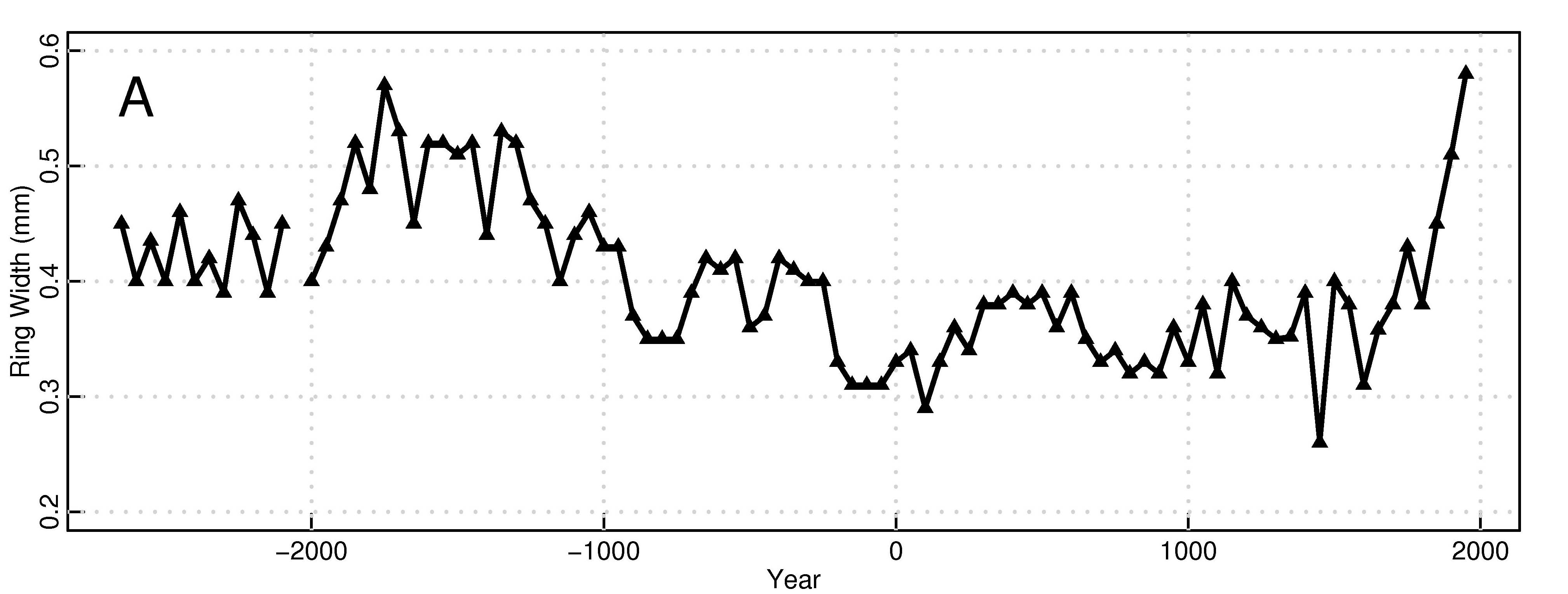Some of the highest growing trees in the world are also the oldest—bristlecone pines (Pinus longaeva) from the Great Basin in the western United States (eastern California, Nevada and Utah). The oldest example is more than 4800 years old. Because of their longevity and growth at high elevations (where the growth of trees is generally known to be limited by temperature) bristlecone pines have been of particular interest to dendroclimatologists (paleoclimatologists who study tree rings to reconstruct past climate). Numerous ecological studies carried out at treeline sites all over the world show that temperature imposes a critical limitation on the ability of trees to produce new tissue; mean daily temperatures of 8-9°C are required, so recent warming will have particular benefits for those trees that have managed to eke out an existence for so long, living “on the edge”.
An interesting characteristic of the western bristlecone pines is that their recent growth has markedly increased—ring widths have been higher than in previous decades. Previous studies have debated to what extent this “fact” is real, or just an artifact of the way tree-ring data are analyzed. Because the growth of trees is radial, as trees get older and the diameter of a tree increases, annual ring widths decline in thickness. This is the normal “growth function” that is commonly removed from measurements before further analysis is carried out. The trick is to do this carefully so that as much climate information is retained while the growth function is discarded, and dendroclimatologists know how to do this quite well. However, sometimes the “standardization” procedure can introduce spurious results. This led some to regard the apparent growth increase in bristlecone pines to be a meaningless result of the data processing. In a new article in the Proceedings of the U.S. National Academy of Sciences (PNAS) Matthew Salzer (Laboratory of Tree Ring Research, University of Arizona) and colleagues examine this issue head on. They studied hundreds of trees from treeline sites in the Great Basin, aligned all the samples according to date, and simply averaged the results (Figure 1). Given that these trees are all long-lived, the complicating factor of growth function (which is strongest for the early growth of a tree) was not significant for assessing the most recent growth. Their results show that mean ring width in the last 50 years has been greater than in any previous 50 year period over the last 3700 years. You have to go all the way back to ~1900-1300 B.C. to find mean ring widths approaching recent values. Furthermore, the recent increase in ring widths is seen in trees at the upper forest border at sites hundreds of km away (even when the treelines there were at lower elevations)—but not in trees below the upper forest border. Below the zone closest to treeline, wide rings are formed in cool, wet years, and narrow rings in warm, dry years, and trees from this lower zone do not show the 20th century growth surge.
It is thus clear that the bristlecone pines from the highest regions, close to their growth limit, are showing a very strong response to recent warming, and indicating just how unusual it has been in the context of the last few millennia. Previous explanations have focused on possible CO2 fertilization effects (increasing water use efficiency) but there is no obvious reason why such factors would have affected only trees within approximately 150m of local treeline in different locations. Rather, the high elevation trees, close to the limit of growth, have responded positively to the recent increase in temperature just as ecological studies would have predicted.
One final note: bristlecone pines often have an unusual growth form known as “strip bark morphology” in which annual growth layers are restricted to only parts of a tree’s circumference. Some studies have suggested that such trees be avoided for paleoclimatic purposes, a point repeated in a recent National Academy of Sciences report (Surface temperature reconstructions for the last 2,000 years. NRC, 2006). However Salzer et al’s study shows that there is no significant difference in their results when the data are divided into two classes—strip bark and non-strip-bark cases –when the raw unstandardized data are compared. So that particular issue has apparently had people barking up the wrong tree…

Figure 1: Median ring-widths (non-overlapping 50-year means) of upper forest border Pinus longaeva from 3 sites in western North America, plotted on first year of interval (from Salzer et al, PNAS, 2009)
 Ray Bradley is Director of the Climate System Research Center (
Ray Bradley is Director of the Climate System Research Center (